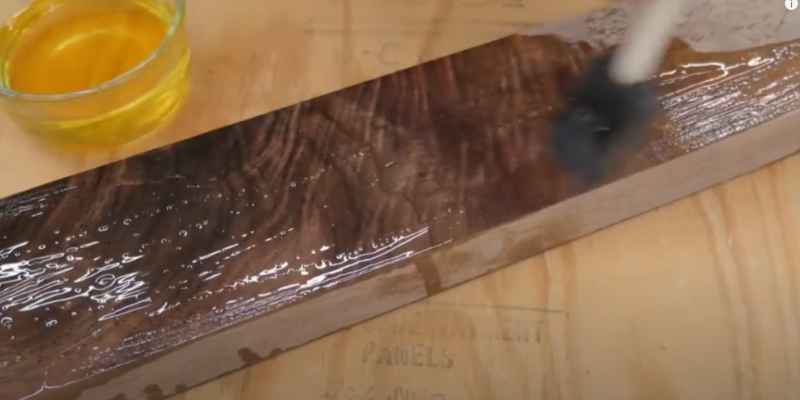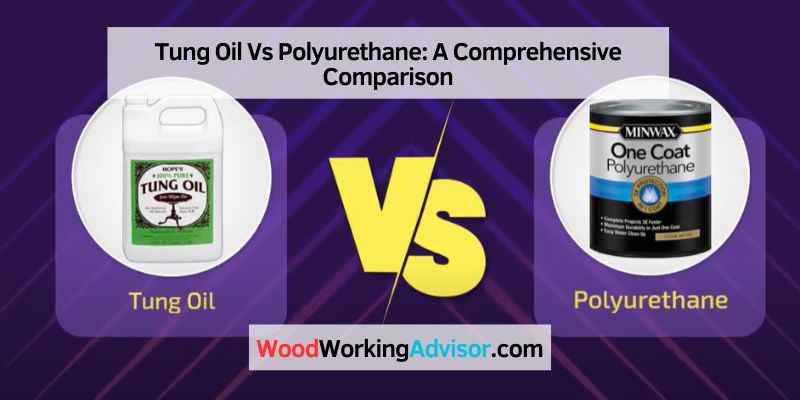Tung oil and polyurethane are two popular finishes used to protect and beautify wooden surfaces. Tung oil is a natural oil derived from the tung tree, while polyurethane is a synthetic product.
Both finishes offer excellent durability and water resistance, but tung oil provides a more natural, matte finish, while polyurethane offers a glossy, plastic-like appearance. Tung oil and polyurethane are two widely used finishes for protecting and enhancing wooden surfaces. While both options deliver excellent durability and water resistance, they differ in terms of their composition and finish.
Tung oil, a natural oil derived from the tung tree, leaves a more authentic, matte appearance on wood, whereas polyurethane offers a glossy, plastic-like finish. We will explore the characteristics of each finish, their applications, and the pros and cons of using them. By understanding their differences, you can make an informed decision when choosing the right finish for your project.
Pros And Cons Of Tung Oil
Are you considering Tung Oil or polyurethane for your next woodworking project? Both options come with their own advantages and disadvantages, and it’s essential to understand each one before making your decision. In this section, we’ll explore the pros and cons of Tung Oil in detail, helping you make an informed choice for your project.
Pros Of Tung Oil
Tung Oil offers several benefits that make it a popular choice among woodworkers:
- Natural and Eco-Friendly: Tung Oil is derived from the seeds of the tung tree and is a natural, non-toxic, and eco-friendly finish. It contains no harmful chemicals and is an excellent choice for those who prioritize sustainability.
- Enhances Wood Grain: Tung Oil has a unique ability to enhance the natural beauty of wood. It penetrates deep into the grain, allowing the wood’s texture and color to shine through while creating a warm, natural look.
- Water-Resistant: Tung Oil forms a protective layer on the wood surface, making it highly resistant to water damage. It helps prevent moisture from penetrating the wood, reducing the risk of warping, cracking, or rotting.
- Easier Application and Maintenance: Tung Oil is easy to apply, whether you choose the pure oil or a pre-mixed variant. It dries relatively quickly and requires minimal maintenance. If the wood surface becomes worn over time, a simple reapplication can restore its beauty.
- Durable and Long-Lasting: Tung Oil forms a hard, durable finish that can withstand regular wear and tear. It provides excellent protection against scratches, stains, and UV radiation, ensuring that your woodwork maintains its appearance for years to come.
Cons Of Tung Oil
While Tung Oil offers numerous advantages, it’s essential to consider its downsides as well:
- Slow Drying Time: One of the primary drawbacks of Tung Oil is its slow drying time. Depending on the environmental conditions, it can take anywhere from 24 hours to several days to dry completely. This extended drying period may not be ideal for projects that require a quick turnaround time.
- Potential Allergic Reactions: Tung Oil is derived from nuts, and individuals with nut allergies may experience adverse reactions when exposed to the oil or its fumes. It’s crucial to take the necessary precautions, such as wearing gloves and ensuring proper ventilation, when working with Tung Oil.
- Require Multiple Coats: Achieving the desired level of protection and finish may require multiple coats of Tung Oil. Each coat needs time to dry before applying the next, which can prolong the overall project completion time.
- Lower Chemical Resistance: While Tung Oil is resistant to water, it has lower resistance to certain chemicals compared to other finishes like polyurethane. Spills or exposure to certain chemicals may cause the finish to become hazy or discolored.
Now that you have a clear understanding of the pros and cons of Tung Oil, you can weigh them against your project’s requirements and make an informed decision. Remember, each finish has its own unique characteristics, and choosing the right one will ultimately depend on your specific needs and preferences.

Pros And Cons Of Polyurethane
When it comes to choosing the right finish for your wood project, polyurethane is a popular choice due to its durability and versatility. However, like any other product, it also has its own set of advantages and disadvantages. In this section, we will explore the Pros and Cons of Polyurethane to help you make an informed decision.
Pros Of Polyurethane
Polyurethane is widely known for its exceptional protective qualities and ability to enhance the appearance of wood. Here are some key advantages:
- 1. Durability: Polyurethane forms an incredibly tough and long-lasting protective layer on the wood surface, shielding it from scratches, dents, UV rays, and moisture. This makes it ideal for high-traffic areas or pieces that will be exposed to the elements.
- 2. Versatility: Available in different formulations such as oil-based, water-based, and high-performance, polyurethane offers choices to suit various wood types and project requirements. It can be used on both interior and exterior surfaces, including floors, furniture, cabinets, and trim.
- 3. Easy Application: Applying polyurethane is relatively simple, whether by brush, spray, or wipe-on methods. It dries quickly, allowing for multiple coats if desired, and can be easily cleaned up with mineral spirits or soap and water.
- 4. Enhances Natural Beauty: Polyurethane provides a clear and glossy finish that enhances the natural color and grain of the wood. It brings out the depth and richness, giving your project a polished and professional look.
- 5. A Choice of Sheens: Whether you prefer a high-gloss, semi-gloss, or satin finish, polyurethane offers a range of sheen options to suit your personal preference and the style of your project.
Cons Of Polyurethane
While polyurethane has many advantages, it is essential to consider its potential drawbacks:
- 1. Strong Odor: Some polyurethane formulations have a distinct and lingering smell, particularly oil-based types. Adequate ventilation is necessary when applying, and it may require time for the odor to dissipate after the finish has cured.
- 2. Longer Drying Time: Compared to other finishes, polyurethane often requires a longer drying time between coats. This can prolong the overall project timeline and may require additional patience and planning.
- 3. Requires Surface Preparation: To achieve the best results, proper surface preparation is crucial before applying polyurethane. This may involve sanding, cleaning, and ensuring the wood is free from dust, debris, or previous finishes.
- 4. Potential Yellowing: Over time, certain polyurethane formulations, especially oil-based ones, may develop a yellowish tint. While this can add warmth to certain wood types, it may alter the appearance of lighter woods or projects where color clarity is desired.
- 5. Not Environmentally Friendly: Some types of polyurethane contain volatile organic compounds (VOCs) that can contribute to air pollution and potential health risks. There are, however, water-based polyurethanes available that have lower VOC emissions and are considered more eco-friendly alternatives.
Comparison Between Tung Oil And Polyurethane
When it comes to finishing wood surfaces, there are various options available, each with its own set of characteristics. Two popular choices are Tung Oil and Polyurethane. In this article, we will compare the ease of application, durability, appearance, maintenance, and environmental impact of these two finishes, allowing you to make an informed decision for your woodworking projects.
Ease Of Application
Both Tung Oil and Polyurethane have their advantages and disadvantages when it comes to ease of application. Tung Oil is a penetrating finish that requires multiple coats, typically applied with a brush or cloth. It tends to be easier to apply in terms of technique, as it does not require extensive sanding between coats. On the other hand, Polyurethane is a surface finish that forms a protective layer on top of the wood. It can be applied with a brush, roller, or spray gun. However, Polyurethane requires more careful preparation and sanding between coats to achieve a smooth, flawless finish.
Durability
When it comes to durability, Polyurethane has the upper hand. It forms a hard, protective coating that is resistant to scratches, stains, and water damage. Polyurethane is often the preferred choice for high-traffic areas or pieces that will be subjected to a lot of wear and tear. Tung Oil, on the other hand, provides a more natural, matte finish that enhances the wood’s natural beauty. While Tung Oil offers some protection against moisture and minor stains, it may require more frequent reapplication compared to Polyurethane.
Appearance
Both Tung Oil and Polyurethane offer distinct appearances. Tung Oil enhances the natural grain and color of the wood, providing a warm, rich finish. It leaves a soft, satin-like sheen that develops a beautiful patina over time. Polyurethane, on the other hand, provides a glossy and often more uniform finish. It can slightly darken the wood and create a more contemporary look. The choice between the two finishes ultimately depends on your desired aesthetic and the type of wood you are working with.
Maintenance
Maintenance is an important factor to consider when choosing a finish for your wood projects. Tung Oil requires periodic reapplication to maintain its protective properties and appearance. This involves lightly sanding the surface and applying additional coats as needed. Polyurethane, on the other hand, is more durable and requires less frequent maintenance. It can be easily cleaned with a mild detergent and water, making it a convenient option for busy households.
Environmental Impact
In terms of environmental impact, Tung Oil is considered more eco-friendly compared to Polyurethane. Tung Oil is derived from the nut of the tung tree and is considered a renewable resource. It does not contain harmful volatile organic compounds (VOCs) and is biodegradable. Polyurethane, on the other hand, is a synthetic finish that can release VOCs into the air during application and drying. Some manufacturers offer low-VOC or water-based Polyurethane options, which are more environmentally friendly.

Frequently Asked Questions For Tung Oil Vs Polyurethane
What Are The Disadvantages Of Tung Oil?
Tung oil has some drawbacks. It takes a long time to dry completely, which can delay projects. It may darken wood with an amber hue. Additionally, it requires regular maintenance and reapplication for optimal protection.
Should I Polyurethane Over Tung Oil?
Yes, you can apply polyurethane over tung oil. Polyurethane provides an additional level of protection and durability to the wood surface. However, proper surface preparation is essential for good adhesion. Sand the tung oil surface, clean it thoroughly, and then apply the polyurethane following the manufacturer’s instructions.
Is Polyurethane Better Than Oil?
Polyurethane is better than oil due to its enhanced durability, protection, and resistance to stains, scratches, and water damage. It also provides a smoother finish and is available in different sheens. Its longer lifespan makes it a popular choice for sealing wood surfaces.
Does Tung Oil Waterproof Wood?
Yes, tung oil can waterproof wood effectively. It creates a protective barrier that repels water and prevents absorption. Tung oil penetrates deep into the wood, enhancing its durability and resistance to moisture. It is a popular choice for finishing outdoor furniture, decks, and wooden boats.
Conclusion
To sum it up, both tung oil and polyurethane have their own set of advantages and disadvantages when it comes to wood finishing. Tung oil offers a natural, durable finish while retaining the natural beauty of the wood. On the other hand, polyurethane provides a highly protective and glossy finish.
Ultimately, your choice should be based on your preference for appearance, durability, and maintenance. It’s important to carefully assess your needs and desired outcome before making a decision. Happy woodworking!


